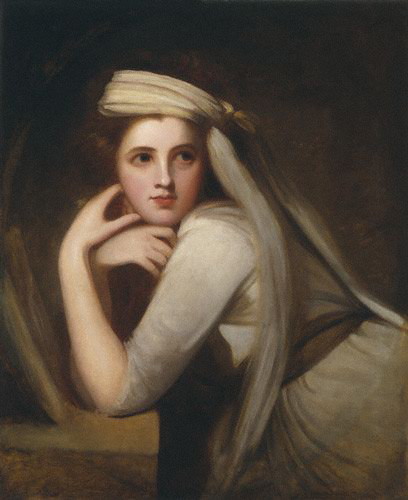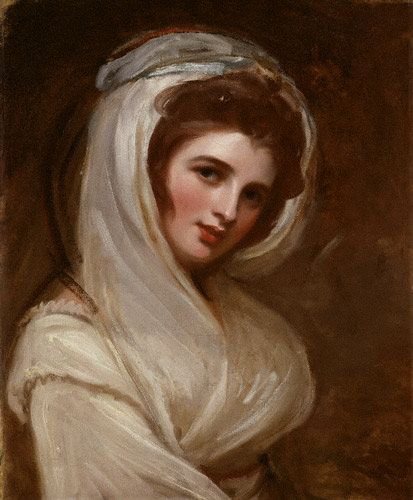Emma, Lady Hamilton (1785), George Romney
Here is number two in my series of posts-that-are-an-excuse-to-chat-about-artwork; hopefully it will live up to the high critical acclaim received as a result of the first… Rofling aside, the following ten or so will be in response to a recent visit I made to the National Portrait Gallery in London, which just happens to be one of my all time favourite galleries – actually, it is my all time favourite gallery – playing host to a long list of British faces since 2nd December, 1856. The primary collection contains 11,000 paintings, drawings and sculptures ranging from the 16th century to the present and, in the summer, includes the famous and highly competitive BP Portrait Award competition – a marvellous platform for any aspiring portrait artist.
Right then, on to the business of the paintings. Oh and please forgive me if you happen upon any blinding inaccuracies regarding the artist and his/her artwork. It is purely ignorance.
I discovered this beauty by George Romney whilst meandering my way through room seventeen of the Regency section. Emily, Lady Hamilton (née Hart) is her name and extra-marital relations was her game. Tut-tut. Yes, the baby-faced twenty-year-old daughter of a blacksmith you see in the picture was somewhat of a professional mistress; one lover even being that well-known man with one arm, Horatio Nelson. A face like this demands a proper introduction, don’t you think?
Born Amy Lyon to blacksmith Henry Lyon and Mary Kidd, she grew up in the Welsh village of Hawarden with only her mother for company, due to the untimely death of her father when she was only two months old. She later changed her name to Emma Hart for some reason (perhaps ‘Amy’ was associated with being poor, I dunno). Blessed with good looks and aspirations to perform, Emma had several stints working as a model, dancer and amateur actress, before securing her first mistressing gig, aged only fifteen, for Sir Harry Featherstonhaugh. Sir Harry proved to be an insensitive host, however, inspiring the transferral of her affections onto one of his more honest and honourable friends, Charles Francis Greville. It appeared to be a happy ending, apart from the fact that Emma was pregnant with the child of former lover, Harry. Whoops. She decided that the most practical solution would be to entrust the infant into the care of relatives, yet making sure to remain in regular contact.
It was whilst she was mistress to Greville that Emma met the artist, George Romney, who was inspired – if not besotted – by her charming looks, thus resulting in a glut of ‘Emma’ portraits from the fellow. This elevated Emma’s status and she soon became known as ‘that beautiful, clever and funny girl’ amongst high society. Sickening. This dream was to be shattered, however, and to cut a long story short, Greville wanted to get married so palmed off twenty-six-year old Emma onto his uncle, sixty-year-old Sir William Hamilton, whom she later married. Nice.
This is all very interesting, but what about that talk of Nelson, someone I’ve actually heard of? Well, Emma’s new hubby, William, happened to be the British Envoy so, whilst visiting Naples, they naturally welcomed in the wounded admiral with open arms. What a mistake. Nelson and Emma quickly fell for each other; became lovers (classic Emma) and had a child together. Phew. An international scandal over their heads, they returned to England to live for a few years. Once her various lovers/husbands had died/left for war, she ended her days in poverty. The End. (I thought I’d better wrap it up otherwise I’d lose you, if I haven’t already…!)
When it comes to assessing the meaning behind the piece/s in question, we need to refer back to Romney’s encounters with young Emma. They were introduced through Francis Greville, who intended to only have a few paintings commissioned of the lady for reasons close to his wallet, but subsequently George became rather struck with her, deeming Emma to be ‘the divine lady … superior to all womankind’ (Letter, 19 June 1791). Quite the complement, don’t you think? It appears that the chap became rather obsessed with Miss Hart, impelling the production of more than sixty pieces, which could be divided into four categories: life studies; allegorical and symbolic; genre scenes; and expressive sketches. The paintings above fit nicely into the life study category, making use of Romney characteristic soft, muted colours – I know I mention this all the time, but it is such a nod to the sfumato technique as employed by the Renaissance masters, da Vinci and Raphael. There are, in particular, strong Raphaelite qualities about the style in which Emma was painted; a style which prides itself on immortalising any subject into a sublime and ethereal beauty, where perfection is but a whisper away. Of course, it did help that Emma was stunningly gorgeous in the first place – there is a definite aura of porcelain doll about her.
If we look back then to assessing what exactly Romney’s designs were for these two studies, we can see that he is trying to subtly represent the various personality traits (mentioned above and here: wit, charm, grace, intelligence etc.) of the captivating individual through use of suggestive gestures and looks – the playful tilting of the head; the meaningful glance and the positioning of the hands.
Lastly, I shall explain to you just why I absolutely love the work by the hand of the infatuated George Romney. Primarily I think that, along with most human beings, I am fascinated by the notion of aesthetic perfection – the flawless, velvet skin; glossy, wide eyes; button nose and pert, berry lips – and on this, Romney delivers in abundance. There is also nothing harsh about the images, as the subject appears to melt into view from the darkness; creating a charming appearance of curiosity and coyness. I am one for using this technique in my own work, for the main reason of making the subject stand out against the background – like in Annie for example – but obviously Romney does it far better. In addition, I take great delight in following the paths of the expressive brushstrokes used in the second piece to illustrate the flowing attire worn by Emma. As a sucker for great drapery, this is somewhat of a refreshing alternative to the refined techniques of, say, da Vinci.
Overall, fantastic artist, gorgeous sitter; the dream combination for any portrait exhibition, no?

